Yongbing Zhang
PathMR: Multimodal Visual Reasoning for Interpretable Pathology Diagnosis
Aug 28, 2025Abstract:Deep learning based automated pathological diagnosis has markedly improved diagnostic efficiency and reduced variability between observers, yet its clinical adoption remains limited by opaque model decisions and a lack of traceable rationale. To address this, recent multimodal visual reasoning architectures provide a unified framework that generates segmentation masks at the pixel level alongside semantically aligned textual explanations. By localizing lesion regions and producing expert style diagnostic narratives, these models deliver the transparent and interpretable insights necessary for dependable AI assisted pathology. Building on these advancements, we propose PathMR, a cell-level Multimodal visual Reasoning framework for Pathological image analysis. Given a pathological image and a textual query, PathMR generates expert-level diagnostic explanations while simultaneously predicting cell distribution patterns. To benchmark its performance, we evaluated our approach on the publicly available PathGen dataset as well as on our newly developed GADVR dataset. Extensive experiments on these two datasets demonstrate that PathMR consistently outperforms state-of-the-art visual reasoning methods in text generation quality, segmentation accuracy, and cross-modal alignment. These results highlight the potential of PathMR for improving interpretability in AI-driven pathological diagnosis. The code will be publicly available in https://github.com/zhangye-zoe/PathMR.
IPGPhormer: Interpretable Pathology Graph-Transformer for Survival Analysis
Aug 17, 2025Abstract:Pathological images play an essential role in cancer prognosis, while survival analysis, which integrates computational techniques, can predict critical clinical events such as patient mortality or disease recurrence from whole-slide images (WSIs). Recent advancements in multiple instance learning have significantly improved the efficiency of survival analysis. However, existing methods often struggle to balance the modeling of long-range spatial relationships with local contextual dependencies and typically lack inherent interpretability, limiting their clinical utility. To address these challenges, we propose the Interpretable Pathology Graph-Transformer (IPGPhormer), a novel framework that captures the characteristics of the tumor microenvironment and models their spatial dependencies across the tissue. IPGPhormer uniquely provides interpretability at both tissue and cellular levels without requiring post-hoc manual annotations, enabling detailed analyses of individual WSIs and cross-cohort assessments. Comprehensive evaluations on four public benchmark datasets demonstrate that IPGPhormer outperforms state-of-the-art methods in both predictive accuracy and interpretability. In summary, our method, IPGPhormer, offers a promising tool for cancer prognosis assessment, paving the way for more reliable and interpretable decision-support systems in pathology. The code is publicly available at https://anonymous.4open.science/r/IPGPhormer-6EEB.
AHDMIL: Asymmetric Hierarchical Distillation Multi-Instance Learning for Fast and Accurate Whole-Slide Image Classification
Aug 07, 2025Abstract:Although multi-instance learning (MIL) has succeeded in pathological image classification, it faces the challenge of high inference costs due to the need to process thousands of patches from each gigapixel whole slide image (WSI). To address this, we propose AHDMIL, an Asymmetric Hierarchical Distillation Multi-Instance Learning framework that enables fast and accurate classification by eliminating irrelevant patches through a two-step training process. AHDMIL comprises two key components: the Dynamic Multi-Instance Network (DMIN), which operates on high-resolution WSIs, and the Dual-Branch Lightweight Instance Pre-screening Network (DB-LIPN), which analyzes corresponding low-resolution counterparts. In the first step, self-distillation (SD), DMIN is trained for WSI classification while generating per-instance attention scores to identify irrelevant patches. These scores guide the second step, asymmetric distillation (AD), where DB-LIPN learns to predict the relevance of each low-resolution patch. The relevant patches predicted by DB-LIPN have spatial correspondence with patches in high-resolution WSIs, which are used for fine-tuning and efficient inference of DMIN. In addition, we design the first Chebyshev-polynomial-based Kolmogorov-Arnold (CKA) classifier in computational pathology, which improves classification performance through learnable activation layers. Extensive experiments on four public datasets demonstrate that AHDMIL consistently outperforms previous state-of-the-art methods in both classification performance and inference speed. For example, on the Camelyon16 dataset, it achieves a relative improvement of 5.3% in accuracy and accelerates inference by 1.2.times. Across all datasets, area under the curve (AUC), accuracy, f1 score, and brier score show consistent gains, with average inference speedups ranging from 1.2 to 2.1 times. The code is available.
The Four Color Theorem for Cell Instance Segmentation
Jun 11, 2025Abstract:Cell instance segmentation is critical to analyzing biomedical images, yet accurately distinguishing tightly touching cells remains a persistent challenge. Existing instance segmentation frameworks, including detection-based, contour-based, and distance mapping-based approaches, have made significant progress, but balancing model performance with computational efficiency remains an open problem. In this paper, we propose a novel cell instance segmentation method inspired by the four-color theorem. By conceptualizing cells as countries and tissues as oceans, we introduce a four-color encoding scheme that ensures adjacent instances receive distinct labels. This reformulation transforms instance segmentation into a constrained semantic segmentation problem with only four predicted classes, substantially simplifying the instance differentiation process. To solve the training instability caused by the non-uniqueness of four-color encoding, we design an asymptotic training strategy and encoding transformation method. Extensive experiments on various modes demonstrate our approach achieves state-of-the-art performance. The code is available at https://github.com/zhangye-zoe/FCIS.
RadioDUN: A Physics-Inspired Deep Unfolding Network for Radio Map Estimation
Jun 10, 2025Abstract:The radio map represents the spatial distribution of spectrum resources within a region, supporting efficient resource allocation and interference mitigation. However, it is difficult to construct a dense radio map as a limited number of samples can be measured in practical scenarios. While existing works have used deep learning to estimate dense radio maps from sparse samples, they are hard to integrate with the physical characteristics of the radio map. To address this challenge, we cast radio map estimation as the sparse signal recovery problem. A physical propagation model is further incorporated to decompose the problem into multiple factor optimization sub-problems, thereby reducing recovery complexity. Inspired by the existing compressive sensing methods, we propose the Radio Deep Unfolding Network (RadioDUN) to unfold the optimization process, achieving adaptive parameter adjusting and prior fitting in a learnable manner. To account for the radio propagation characteristics, we develop a dynamic reweighting module (DRM) to adaptively model the importance of each factor for the radio map. Inspired by the shadowing factor in the physical propagation model, we integrate obstacle-related factors to express the obstacle-induced signal stochastic decay. The shadowing loss is further designed to constrain the factor prediction and act as a supplementary supervised objective, which enhances the performance of RadioDUN. Extensive experiments have been conducted to demonstrate that the proposed method outperforms the state-of-the-art methods. Our code will be made publicly available upon publication.
Category Prompt Mamba Network for Nuclei Segmentation and Classification
Mar 13, 2025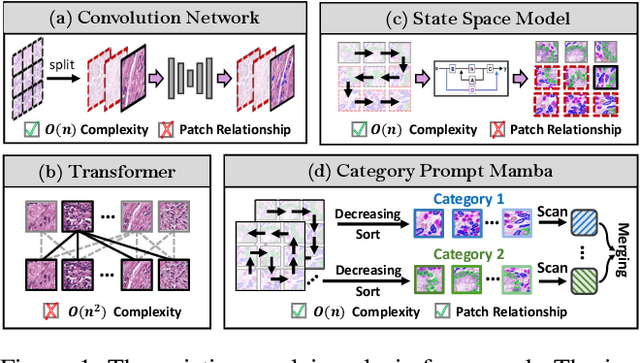



Abstract:Nuclei segmentation and classification provide an essential basis for tumor immune microenvironment analysis. The previous nuclei segmentation and classification models require splitting large images into smaller patches for training, leading to two significant issues. First, nuclei at the borders of adjacent patches often misalign during inference. Second, this patch-based approach significantly increases the model's training and inference time. Recently, Mamba has garnered attention for its ability to model large-scale images with linear time complexity and low memory consumption. It offers a promising solution for training nuclei segmentation and classification models on full-sized images. However, the Mamba orientation-based scanning method lacks account for category-specific features, resulting in sub-optimal performance in scenarios with imbalanced class distributions. To address these challenges, this paper introduces a novel scanning strategy based on category probability sorting, which independently ranks and scans features for each category according to confidence from high to low. This approach enhances the feature representation of uncertain samples and mitigates the issues caused by imbalanced distributions. Extensive experiments conducted on four public datasets demonstrate that our method outperforms state-of-the-art approaches, delivering superior performance in nuclei segmentation and classification tasks.
Prototype-Guided Cross-Modal Knowledge Enhancement for Adaptive Survival Prediction
Mar 13, 2025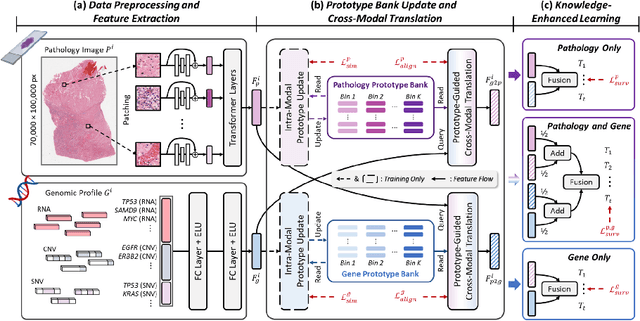
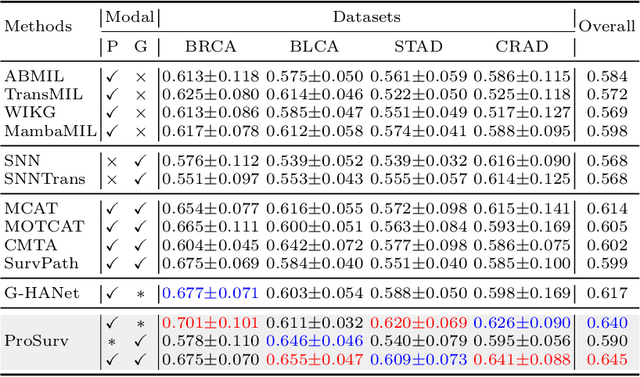
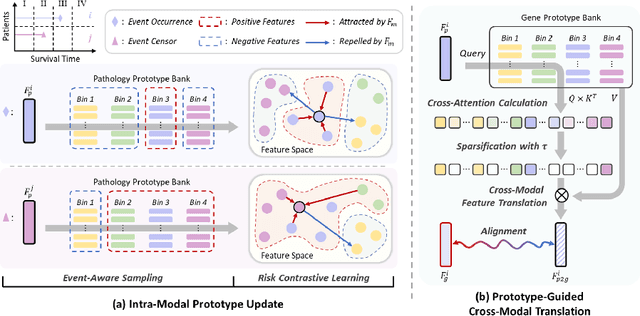
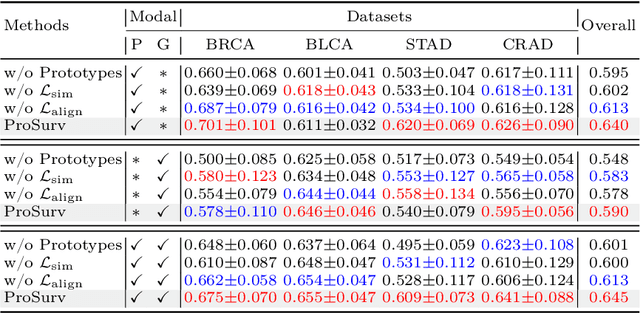
Abstract:Histo-genomic multimodal survival prediction has garnered growing attention for its remarkable model performance and potential contributions to precision medicine. However, a significant challenge in clinical practice arises when only unimodal data is available, limiting the usability of these advanced multimodal methods. To address this issue, this study proposes a prototype-guided cross-modal knowledge enhancement (ProSurv) framework, which eliminates the dependency on paired data and enables robust learning and adaptive survival prediction. Specifically, we first introduce an intra-modal updating mechanism to construct modality-specific prototype banks that encapsulate the statistics of the whole training set and preserve the modality-specific risk-relevant features/prototypes across intervals. Subsequently, the proposed cross-modal translation module utilizes the learned prototypes to enhance knowledge representation for multimodal inputs and generate features for missing modalities, ensuring robust and adaptive survival prediction across diverse scenarios. Extensive experiments on four public datasets demonstrate the superiority of ProSurv over state-of-the-art methods using either unimodal or multimodal input, and the ablation study underscores its feasibility for broad applicability. Overall, this study addresses a critical practical challenge in computational pathology, offering substantial significance and potential impact in the field.
Fast and Accurate Gigapixel Pathological Image Classification with Hierarchical Distillation Multi-Instance Learning
Feb 28, 2025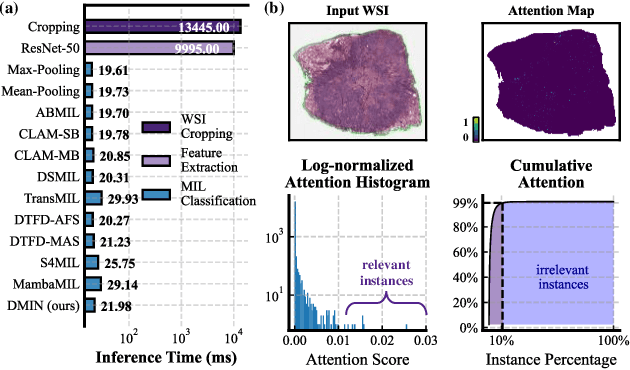
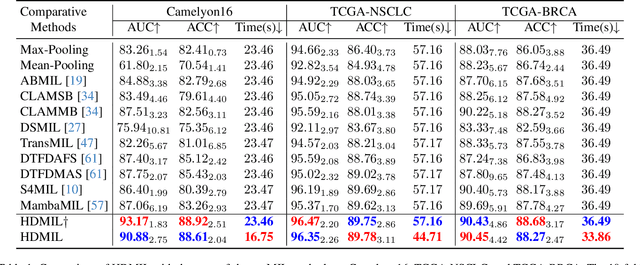
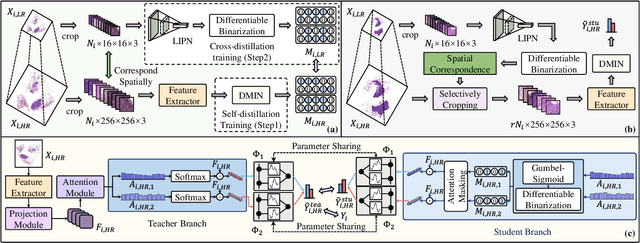
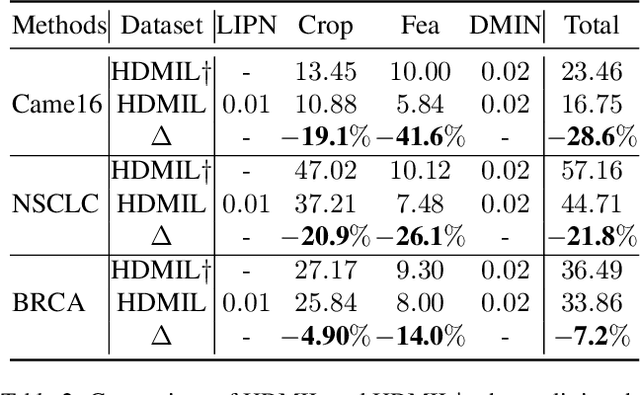
Abstract:Although multi-instance learning (MIL) has succeeded in pathological image classification, it faces the challenge of high inference costs due to processing numerous patches from gigapixel whole slide images (WSIs). To address this, we propose HDMIL, a hierarchical distillation multi-instance learning framework that achieves fast and accurate classification by eliminating irrelevant patches. HDMIL consists of two key components: the dynamic multi-instance network (DMIN) and the lightweight instance pre-screening network (LIPN). DMIN operates on high-resolution WSIs, while LIPN operates on the corresponding low-resolution counterparts. During training, DMIN are trained for WSI classification while generating attention-score-based masks that indicate irrelevant patches. These masks then guide the training of LIPN to predict the relevance of each low-resolution patch. During testing, LIPN first determines the useful regions within low-resolution WSIs, which indirectly enables us to eliminate irrelevant regions in high-resolution WSIs, thereby reducing inference time without causing performance degradation. In addition, we further design the first Chebyshev-polynomials-based Kolmogorov-Arnold classifier in computational pathology, which enhances the performance of HDMIL through learnable activation layers. Extensive experiments on three public datasets demonstrate that HDMIL outperforms previous state-of-the-art methods, e.g., achieving improvements of 3.13% in AUC while reducing inference time by 28.6% on the Camelyon16 dataset.
HisynSeg: Weakly-Supervised Histopathological Image Segmentation via Image-Mixing Synthesis and Consistency Regularization
Dec 30, 2024



Abstract:Tissue semantic segmentation is one of the key tasks in computational pathology. To avoid the expensive and laborious acquisition of pixel-level annotations, a wide range of studies attempt to adopt the class activation map (CAM), a weakly-supervised learning scheme, to achieve pixel-level tissue segmentation. However, CAM-based methods are prone to suffer from under-activation and over-activation issues, leading to poor segmentation performance. To address this problem, we propose a novel weakly-supervised semantic segmentation framework for histopathological images based on image-mixing synthesis and consistency regularization, dubbed HisynSeg. Specifically, synthesized histopathological images with pixel-level masks are generated for fully-supervised model training, where two synthesis strategies are proposed based on Mosaic transformation and B\'ezier mask generation. Besides, an image filtering module is developed to guarantee the authenticity of the synthesized images. In order to further avoid the model overfitting to the occasional synthesis artifacts, we additionally propose a novel self-supervised consistency regularization, which enables the real images without segmentation masks to supervise the training of the segmentation model. By integrating the proposed techniques, the HisynSeg framework successfully transforms the weakly-supervised semantic segmentation problem into a fully-supervised one, greatly improving the segmentation accuracy. Experimental results on three datasets prove that the proposed method achieves a state-of-the-art performance. Code is available at https://github.com/Vison307/HisynSeg.
Efficient Self-Supervised Video Hashing with Selective State Spaces
Dec 19, 2024



Abstract:Self-supervised video hashing (SSVH) is a practical task in video indexing and retrieval. Although Transformers are predominant in SSVH for their impressive temporal modeling capabilities, they often suffer from computational and memory inefficiencies. Drawing inspiration from Mamba, an advanced state-space model, we explore its potential in SSVH to achieve a better balance between efficacy and efficiency. We introduce S5VH, a Mamba-based video hashing model with an improved self-supervised learning paradigm. Specifically, we design bidirectional Mamba layers for both the encoder and decoder, which are effective and efficient in capturing temporal relationships thanks to the data-dependent selective scanning mechanism with linear complexity. In our learning strategy, we transform global semantics in the feature space into semantically consistent and discriminative hash centers, followed by a center alignment loss as a global learning signal. Our self-local-global (SLG) paradigm significantly improves learning efficiency, leading to faster and better convergence. Extensive experiments demonstrate S5VH's improvements over state-of-the-art methods, superior transferability, and scalable advantages in inference efficiency. Code is available at https://github.com/gimpong/AAAI25-S5VH.
 Add to Chrome
Add to Chrome Add to Firefox
Add to Firefox Add to Edge
Add to Edge